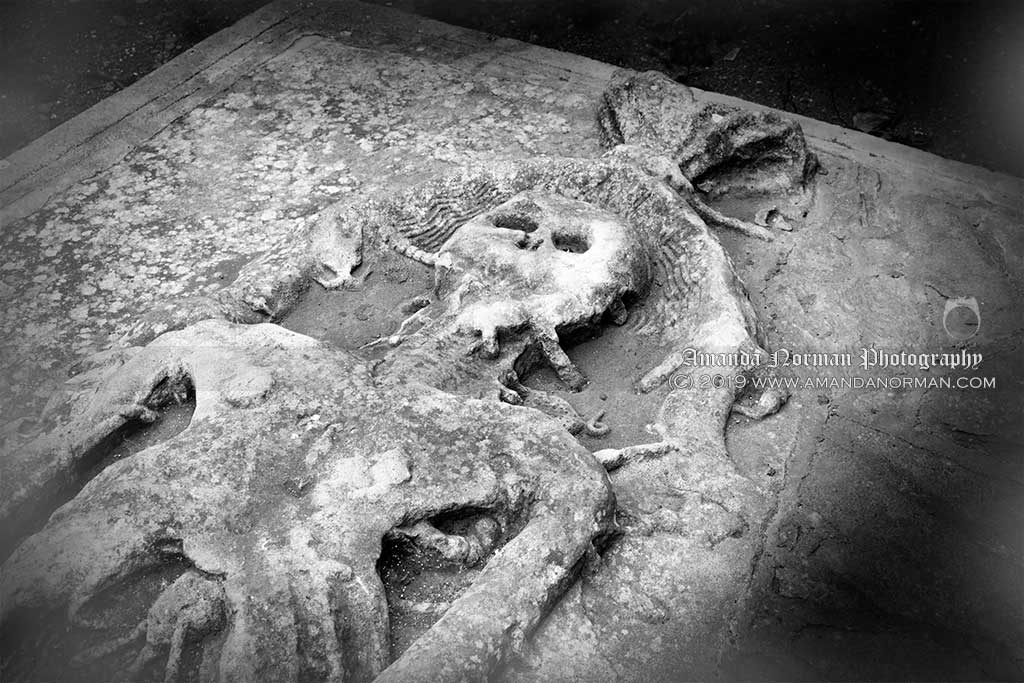Cadaver graves of Ireland is my account of a wonderful trip photographing some amazing specimens.

This stunning cadaver grave stone lies within the ruins of St Christopher’s Chapel in Stamullen.
You will find it next to St Patrick’s Church, which is also in ruins. Looking back on this now, I remember how much trouble it was, locating the site. Thankfully, Mark was not giving up and he eventually found a small enclosed area with a locked gate. As I was peering through the gate at the stone, the range of emotions I was feeling were immense. Would I get to see the stone up close?
I was beginning to feel a little deflated. However, my optimism began rising when I spotted a piece of paper on the floor. More importantly, I could see a name and part of a phone number to call for the key. Excitingly, I began looking up the details on Google due to some missing numbers. I then began speaking to Brendan Matthews who agreed to come and meet us, there and then!
Cadaver Graves of Ireland
Brendan Matthews, is a local historian who works at the Drogheda museum. Furthermore, he was full of historical information about this piece of art and the family of whom it belongs to.
In my opinion, I’m grateful that this wonderful stone is under protection. I also knew that I wouldn’t be able to remember everything that he was telling me. Indeed, I was feeling so excited and grateful for meeting such a wonderful man. Not only this, but sharing his knowledge with us was making my day. Furthermore, he was granting me full access to take pictures. I was most certainly in my element!
There was no way I would be remembering everything he told me. Therefore, I took a photograph of the information sheet that was laminated on the wall. You can read this yourself below.
Stamullen Cadaver Graves
St Christopher’s was the family chapel of the Preston family (Viscounts Gormanston), who resided at Gormanston Castle from the late 14th until the mid 20th century. The chapel here dates to the year 1434. The family burial vault of the Preston’s is covered by two interesting tombstones.
Brendan Matthews
The Cadaver stone depicts the decomposing body of a young woman with numerous reptiles and creatures feeding off the corpse. The woman is shown to wear a headdress with the shroud tied back at the head and feet. It is the oldest of only nine cadaver stones found in Ireland and dates to c. 1450. The cadaver stones came into fashion across Europe following the Black Death of the mid 14th century and subsequent plagues.

Cadaver Stone Keeper
So, Brendan Matthews is responsible for taking care of this lovely piece of art for the current lord. In addition, he maintains the area with a bit of weeding. Furthermore, and much to my delight, he enjoys providing information and access to the graveyard for anyone who is interested.
As soon as I finished photographing the cadaver grave, we made our way out of the enclosure. I remembered seeing a piece of human skull on a mound of Earth, so I began showing it to Brendan. Following my recent trip to Lincolnshire, I am getting used to seeing fragments of human bones in old graveyards. In addition, I’m finding that it is also common to see in Ireland too.
Brendan then picked it up and showed me these two notches on the inside of the skull. In particular, he began telling me that it belonged to a man. Furthermore, he was above the age of 50 and it was these notches that were providing Brendan with the information. Undoubtedly, I was clearly in my element chatting to him and I could have spent a whole day with him.
Thank you Brendan!
It was a real pleasure meeting you and you certainly are responsible for gifting me with some great memories.
Drogheda Cadavers

Can you believe that only a short drive away, you will find more great examples of cadaver stones?
These pair above are waiting for you in St Peter’s churchyard in Drogheda. Walking around the back of the church is where you will find them. Don’t you think that the one on the left looks like an alien?
Summarising Cadaver Graves of Ireland
Within the 14th to 15th century, it was the wealthy during times of the plague who were acquiring cadaver stones. They were often placed over their graves to show the living what is happening to the body once buried. Hence the open shroud showing the newts, frogs, maggots, and more. All are clearly seen feasting upon the rotting flesh. The Stamullen cadaver stone is a fine example of showcasing this.
Also cadaver stones are providing us with an important message.
No matter how much wealth you have, we are all equal in death.
Latin phrases like Memento Mori (remember that you will die), and Memento Vivere (Remember to live) also became popular.
